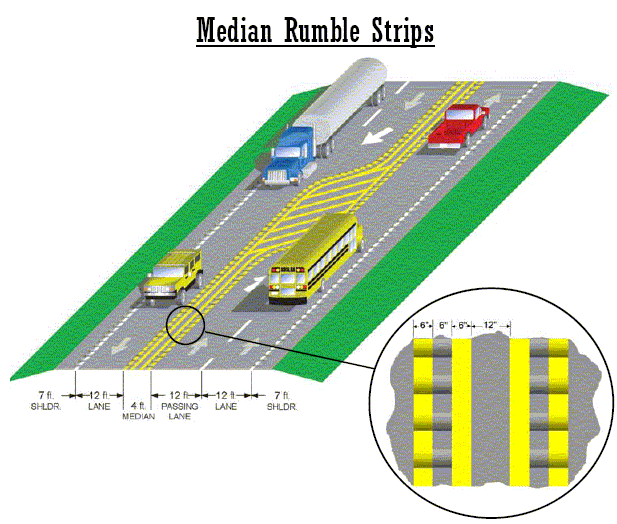Have you ever felt your vehicle vibrate as you drove over a series of bumps on the road? That’s the magic of rumble strips at work! Designed to enhance driver awareness, these textured strips alert drivers when they stray from their lanes or approach a dangerous area. Whether you’re navigating sleepy country roads or bustling highways, understanding the purpose and placement of rumble strips can significantly improve road safety for everyone. So, let’s dive deeper into the world of rumble strips—what they are and the different types you might encounter!
Types of Rumble Strips

Rumble strips come in various forms, each tailored to specific safety needs. Here’s a breakdown of the main types:
- Ground-In Rumble Strips: These are typically carved directly into the pavement during its installation. They have a more permanent feel and are often used on highways. Their deep grooves provide a loud noise and significant vibration, ensuring that any driver who drifts off course is immediately alerted.
- Roll-Formed Rumble Strips: These strips are created using a specialized machine that rolls the strips into the asphalt. They are less invasive than ground-in types and can be added to existing roads. Roll-formed strips are great for both noise and tactile feedback, helping to maintain driver focus.
- Temporary Rumble Strips: Often used in construction zones or for detours, these strips can be made of rubber or plastic. They’re easy to install and remove, making them perfect for situations where road changes are frequent. Their function is similar, alerting drivers to changes in road conditions.
- Shoulder Rumble Strips: Located on the edges of highways, shoulder rumble strips serve to alert drivers when they veer off into the shoulder area. They are particularly important for preventing accidents caused by drowsy driving. The sound and vibration can jolt a sleepy driver back into awareness.
- Centerline Rumble Strips: These are found on the centerline of two-way roads. They help prevent head-on collisions by warning drivers when they drift into oncoming traffic. These strips not only serve as an alert but also aid in maintaining proper lane discipline.
Each type of rumble strip plays a crucial role in enhancing road safety. By understanding their specific applications and benefits, drivers can appreciate how they contribute to safer journeys. Next time you're on the road, take a moment to notice these strips and remember their purpose—keeping you and others safe!
Also Read This: What Makes Rumble Different From Platforms Like YouTube and Vimeo?
3. Benefits of Rumble Strips

Rumble strips are more than just those raised lines you see on the sides of roads. They play a crucial role in enhancing both safety and driving experience. Let’s dive into some of the key benefits:
- Increased Safety: Rumble strips alert drivers when they stray from their lanes or approach dangerous curves. The tactile feedback and noise they produce can help prevent accidents, especially for drowsy or distracted drivers.
- Cost-Effective Solution: Installing rumble strips is relatively inexpensive compared to other safety measures. They require minimal maintenance and can significantly reduce the occurrence of crashes.
- Improved Road Awareness: By providing sensory feedback, rumble strips enhance driver awareness. This is especially beneficial in rural areas where drivers might be less focused.
- Reduction in Speeding: When drivers encounter rumble strips, they often slow down. This natural speed reduction is vital on roads where speeding is a concern, such as near schools or residential areas.
- Versatility: Rumble strips can be used in various environments—highways, rural roads, and even parking lots. They can be tailored to fit specific needs, whether it's alerting drivers about a sharp turn or preventing run-off-the-road crashes.
In essence, rumble strips are a simple yet effective way to enhance road safety and keep drivers alert. The benefits are clear: they save lives and reduce the number of accidents on our roads!
Also Read This: Who Won the Royal Rumble 2024 Men’s Event? WWE’s Highlights and Recap
4. Preparation for Installation
Installing rumble strips might sound straightforward, but a little preparation goes a long way in ensuring effectiveness. Here’s a step-by-step guide to get you started:
- Assess the Location: Before anything, conduct a thorough evaluation of the area where you plan to install the rumble strips. Look for high-accident zones, curves, or areas with a history of driver distraction.
- Gather Necessary Permits: Depending on your location, you may need to obtain permits from local authorities. This ensures that your installation complies with safety regulations and standards.
- Choose the Right Type: There are several types of rumble strips—milled, raised, and preformed. Each type serves different purposes. Milled strips are often used on highways, while raised strips are effective in urban areas. Choose the one that fits your specific needs.
- Plan the Layout: Determine how long and wide your rumble strips should be. Consider spacing and placement for maximum effect. A common layout includes strips placed every few feet, but this can vary based on the road type and traffic patterns.
- Gather Equipment: Make sure you have all the necessary tools and materials for installation. This may include milling machines, concrete or asphalt, paint for visibility, and safety gear for workers.
By taking the time to prepare properly, you can ensure that the installation process is smooth and that the rumble strips effectively enhance road safety. Remember, the goal is to create a safer driving environment for everyone!
Also Read This: Could We Stop the Rumbling? A Look at How to Prevent the Catastrophic Event
5. Step-by-Step Installation Process
Installing rumble strips can significantly improve road safety when done correctly. Here’s a simple step-by-step guide to help you through the installation process:
- Site Assessment: Before you start, assess the area where you plan to install the rumble strips. Look for high-traffic zones or areas with a history of accidents. Make sure to check local regulations related to road modifications.
- Choose the Type of Rumble Strips: There are various types of rumble strips, including milled, raised, and inlaid. Each has its advantages. For example, milled strips are quieter, while raised strips are more effective for alerting drivers.
- Gather Necessary Equipment: Ensure you have all the tools you’ll need, such as a milling machine for milled strips, templates for consistent spacing, and safety gear like cones and reflective vests to mark the work zone.
- Mark the Installation Area: Use chalk or paint to outline where the rumble strips will go. Consistency is key, so make sure they are evenly spaced and aligned with your assessment.
- Prepare the Road Surface: If you’re installing milled strips, you may need to grind a specific depth into the asphalt. Ensure the surface is clear of debris to allow for proper adherence.
- Install the Rumble Strips: Begin the installation by cutting or laying down the rumble strips according to your plan. If you’re using inlaid strips, follow the manufacturer’s instructions for securing them into the existing surface.
- Check for Quality: After installation, inspect the strips to verify they meet depth and width specifications. A quick drive over the strips can help ensure they provide the intended feedback to drivers.
- Cleanup: Finally, remove any excess materials, tools, and debris from the site. Make sure the road is safe for use before reopening it to traffic.
By following these steps, you can ensure a successful rumble strip installation that enhances road safety and boosts driver awareness.
Also Read This: How to Donate on Rumble and Support Your Favorite Creators
6. Best Practices for Effective Usage
Once your rumble strips are installed, it’s essential to ensure they are used effectively. Here are some best practices to maximize their benefits:
- Regular Maintenance: Periodic inspections are crucial. Look for signs of wear, damage, or degradation, especially after heavy storms or road work. Keeping them in good condition ensures they continue to provide the necessary alerts to drivers.
- Proper Signage: Install clear signage before the rumble strips. Signs should warn drivers about the upcoming strips, especially in areas with lower visibility. This proactive measure can enhance the effectiveness of the rumble strips.
- Educate Drivers: Consider running local awareness campaigns. Informing the community about the purpose of rumble strips and how they work can encourage drivers to respect these safety measures.
- Monitor Traffic Patterns: Keep an eye on how traffic behaves around the rumble strips. If they’re not serving their intended purpose, assess the need for adjustments in placement or additional signage.
- Collaborate with Local Authorities: Work together with road maintenance and safety officials to ensure that rumble strips are part of a larger traffic calming strategy. Integration with other safety measures, like speed bumps or better lighting, can enhance overall effectiveness.
By adhering to these best practices, rumble strips can be a vital tool in improving road safety and ensuring a smoother, more aware driving experience for everyone.
Also Read This: How to Monetize Rumble and Maximize Your Earnings as a Content Creator
7. Maintenance and Monitoring of Rumble Strips
Once you’ve installed rumble strips, the journey doesn’t end there! Regular maintenance and monitoring are vital to ensure they continue serving their purpose effectively. Here’s what you need to know:
- Regular Inspections: Schedule routine checks to assess the condition of the rumble strips. Look for signs of wear and tear, such as cracks or erosion, especially after harsh weather conditions.
- Cleaning: Dirt, debris, and vegetation can accumulate on or around rumble strips, diminishing their effectiveness. A simple power wash can help keep them clear and audible.
- Repairing Damage: If you notice any damage like chips or cracks, address them immediately. Using the right materials for repairs ensures that the strips maintain their original function.
- Monitoring Traffic Patterns: Keep an eye on how traffic flows around the rumble strips. If you observe changes, like decreased effectiveness in alerting drivers, it may be time to adjust their placement or redesign.
- Feedback from Drivers: Encourage feedback from road users about the effectiveness of the rumble strips. Sometimes, drivers can offer insights into their experience that quantitative data can’t capture.
By actively maintaining and monitoring your rumble strips, you not only extend their lifespan but also enhance their effectiveness in promoting road safety. This proactive approach can significantly reduce the chances of accidents due to driver inattention.
8. Conclusion: Enhancing Road Safety with Rumble Strips
Rumble strips are more than just a safety feature; they are a lifeline on our roads. By effectively alerting drivers, they play a crucial role in preventing accidents. As we conclude our guide, here are a few key takeaways:
- Awareness: Rumble strips serve as a reminder to stay alert. Their sound and vibration can jolt even the most distracted driver back to attention.
- Cost-Effective Solution: The installation and maintenance of rumble strips are relatively low-cost compared to the price of accidents, making them a smart investment.
- Versatile Applications: Whether on highways, residential streets, or school zones, rumble strips can be adapted to various environments to enhance safety.
- Community Involvement: Engaging local communities in discussions about road safety can foster support for implementing rumble strips where they are most needed.
In conclusion, the thoughtful installation, maintenance, and monitoring of rumble strips contribute significantly to safer roads. By raising awareness and investing in these measures, we can create a safer driving environment for everyone. Let's make road safety a priority—and rumble strips are a great step in that direction!
 admin
admin








